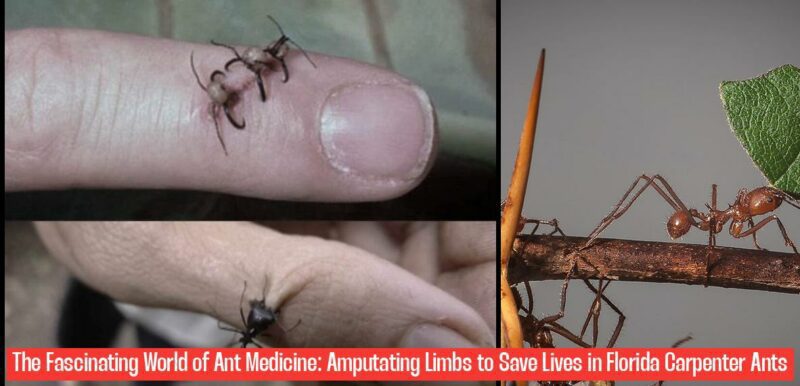The Remarkable Medical Practices of Florida Carpenter Ants
Ah, the incredible world of ant medicine! Imagine a tiny hospital where ants are not just doctors but also surgeons. Yes, you heard it right – these tiny insects are actually performing surgeries, amputating limbs to save their fellow colony members’ lives! It’s like a miniature version of Grey’s Anatomy but with more antennae and less drama.
Now, let’s dive into the remarkable medical practices of Florida Carpenter Ants. These little heroes from the Camponotus floridanus species go above and beyond to care for their injured nestmates. When a comrade suffers a lower-leg injury, instead of sending them a “get well soon” card, these ants skillfully clean the wound. But wait, it gets even more fascinating – they sometimes resort to amputation to ensure the survival of their wounded buddies. Talk about dedication to healthcare!
So, what’s the deal with this ant surgery phenomenon? Well, recent research has shed light on this behavior where ants instinctively know how to treat injuries effectively. If that doesn’t blow your mind, I don’t know what will! These Florida carpenter ants showcase an incredible level of care and compassion within their community.
ASOG Fact: Did you know that some ant species have mastered the art of medical amputation as a means of saving their injured pals? This surgical skill is truly one-of-a-kind in the animal kingdom.
Now, you must be thinking – how do these tiny creatures manage such precise medical procedures without a degree in entomology? Well, it seems that nature has equipped them with an innate understanding of when surgery is necessary to ensure survival. Who knew ants were so medically savvy?
But before you start picturing tiny ant hospitals with operating rooms and scrubs (how adorable would that be?), it’s essential to appreciate the complex yet awe-inspiring nature of these little surgeons in our midst. So buckle up for more intriguing details as we explore further into this captivating realm of insect medicine. Keep reading for more mind-blowing insights!
Understanding Ant Surgery: Why Amputation Saves Lives
Understanding the significance of amputation in ants’ medical practices is crucial for appreciating their intricate caregiving abilities. In humans, not amputating a limb with severe issues like infections or gangrene can lead to tissue death, infections, and potentially life-threatening conditions if left untreated. The decision for amputation typically arises when the limb faces severe infection, gangrene due to arterial disease, diabetes complications, traumatic injuries, deformities affecting function, or limited mobility.
When it comes to the aftermath of amputation – what happens to severed limbs? The standard procedures involve using the removed body parts for medical research or disposing of them as hospital waste. This waste is managed along with other hospital disposables. Amputations are essential when tissue destruction, infection, or diseases render a body part irreparable or life-threatening. Trauma or diseases causing prolonged lack of blood flow can also necessitate surgical removal.
Imagine the tiny ant surgeons contemplating these complex decisions! Research reveals that ants engage in surgical practices selectively on specific leg injuries with a high level of precision and care akin to human medical interventions. These little insects display remarkable diligence in their approach towards treating wounded comrades. As we delve deeper into understanding these minuscule surgeons’ techniques and their impact on colony healthcare dynamics, we uncover an extraordinary world where even the tiniest creatures showcase remarkable medical expertise for ensuring their community’s well-being.
Videos Show Ants Amputating Nest Mates’ Legs: Insights and Implications
Amputating a leg comes with significant costs, with minor amputations averaging around $46,802 and major amputations averaging $73,222. However, excluding outliers, the mean costs decrease to $16,355 for minor amputations and $55,874 for major ones. Determining if an amputation is necessary involves several factors such as severe infections, gangrene due to arterial disease, complications from diabetes, traumatic injuries like crush wounds, or limited functionality in the limb.
— Analysis of Blue Beetle (English) Box Office Performance
- Severe infections in the limb
- Gangrene resulting from peripheral arterial disease
- Complications from diabetes
- Trauma like crush or blast wounds
- Limb deformities affecting movement and function
<
About 54% of surgical amputations stem from conditions affecting blood flow like vascular diseases and diabetes. These chronic issues can lead to tissue death in toes, feet, and legs. Common foot amputation types include toe amputations through phalanges or disarticulation of joints and transmetatarsal partial foot amputations involving metatarsals.
How Ants Use Amputation to Treat Injuries: A Closer Look
In the captivating world of ant medicine, these tiny insects exhibit remarkable behavior when it comes to treating injuries. When an ant is injured, its nestmate will lick the wound, producing a substance with numerous chemical compounds and proteins. This substance acts like a broad-spectrum antibiotic, showcasing the ants’ sophisticated healthcare system. Interestingly, if needed, ants can perform amputations on their comrades to save their lives. This surgical skill is truly exceptional in the animal kingdom and displays their dedication to caring for their community members.
Ants have evolved unique biological mechanisms for survival. Unlike humans, they breathe through tiny holes called spiracles and have a tube-like heart that pumps colorless blood throughout their bodies. Additionally, ants possess compound eyes with multiple units called ommatidia, allowing them to perceive their surroundings in a fascinating way similar to how a traffic light functions.
When it comes to amputation decisions among ants, unpublished data suggests that various ant species demonstrate surgical precision when treating specific injuries. These tiny surgeons carefully bite at joints until a limb is severed if necessary for the injured ant’s well-being. The research on ants’ medical practices not only sheds light on their intricate caregiving abilities but also presents potential opportunities for medical advancements in our own healthcare systems.
Have you ever imagined an ant hospital buzzing with activity? How do you think these tiny surgeons coordinate such delicate procedures without formal training? Ants truly showcase extraordinary skills that challenge our perceptions of insect intelligence and care within their colonies. Let’s continue exploring this enthralling realm of insect medicine and uncover more surprising details about these miniature medical marvels!
What happens if you don’t amputate a leg?
Tissue in the leg will die due to lack of oxygen and nutrients, which leads to infection and gangrene. In some cases, gangrene can be very dangerous as the infection can spread through the body and become life-threatening.
How do you know if your leg needs to be amputated?
If you have a severe infection that is not responding to other treatments, or if the infection is spreading rapidly, amputation may be necessary to prevent further complications and save your life.


